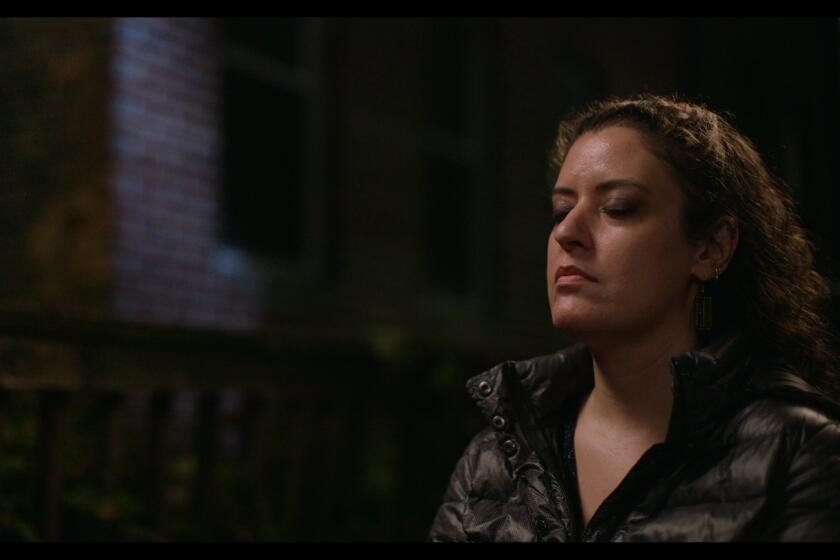REWINDING THROUGH YEAR IN FILM
Ronald Reagan gave what was easily the year’s best leading male performance in the blockbuster Oliver North mystery “The Man Who Knew Too Little,” and newcomer Eugene Hasenfus parlayed a minor supporting role into international stardom in the CIA remake of “Babes in Arms,” which was filmed on location in Nicaragua.
In writing, the year’s most remarkable work was done by the team responsible for “Chaos,” a horror story about tax reform, while in management, the year’s top story was the appointment of William H. Rehnquist--who said some of his best friends are colorized--to Chief Justice of the Supreme Studio.
Wait a minute! I’ve gotten all mixed up here. I’m supposed to be looking back at the year in Hollywood, not Washington.
It wasn’t Reagan who gave the best performance, it was Jeff Goldblum in “The Fly.” Not Hasenfus in Nicaragua; it was James Woods in “Salvador.” It was “Kaos” by the Taviani brothers that the critics raved about, not the new tax law. And I have confused Rehnquist with Ted Turner, who said he wanted to color some of his favorite movies.
It is hard to keep the achievements of these two entertainment centers separate. In front of me right now is an invitation to a movie starring Rita Jenrette. Wasn’t she a U.S. representative, or close to one?
There is a direct track between Washington and Hollywood. G. Gordon Liddy came here from there, and of course, Ronald Reagan went there from here. Charlton Heston and Clint Eastwood may go next. (What a ticket! Moses and Dirty Harry.)
The truth is that Washington puts on a better show than Hollywood and is more fun to think about. Hollywood is famous for creative bookkeeping, but Washington can really do it.
Paramount shipped “Top Gun” to theaters around the U.S. and boasted of selling about $170 million worth of tickets to it. Oliver North shipped “munitions” to Iran and nobody’s even found a receipt yet. Everybody knows Universal Studios spent more than $35 million on “Howard the Duck.” But who paid for the equally ill-fated flight that Hasenfus took?
Anyway, I’m straightened out now and can report that the big news in Hollywood was the fact that five of the nine major studios (a remarkable 55%) finished the year with the same chief executives with whom they began.
Those filing through the exits were Universal’s Frank Price (replaced by Tom Pollock); MGM/UA’s Jerry Weintraub (replaced by Lee Rich); 20th Century Fox’s Alan Horn (replaced by Leonard Goldberg), and Columbia’s Guy McElwaine (replaced by David Puttnam).
To the outgoing, congratulations and enjoy your weekends off. To the incoming, good luck and beware of the agents.
Paramount had by far the best year of any studio, with a mixed bag of teen comedies, action-adventures and sequels that will account for about 20% of the more than $3-billion domestic box office. Its top moneymakers: “Top Gun,” “ ‘Crocodile’ Dundee,” “Ferris Bueller’s Day Off,” “Star Trek IV” and “Pretty in Pink.”
“Star Trek” is still leading the holiday pack, and “The Golden Child,” which could win the “Grease” award as the year’s top-earning bad movie, is right behind it.
Paramount alumnus Michael Eisner earned his mouse ears at Walt Disney Studios this year. With such Touchstone Films adult hits as “Down and Out in Beverly Hills,” “Ruthless People” and “The Color of Money,” Eisner introduced a hipness on Dopey Drive that got people’s attention as far away as Wall Street.
I don’t know which made the bigger noise this year, Bette Midler audibilizing an orgasm in “Down and Out in Beverly Hills,” or old Walt spinning in his grave. But those three R-rated hits, along with a few re-released animated classics and the new “The Great Mouse Detective,” sold more than $200 million worth of tickets for Disney.
The year’s biggest male star, measured by interest at the box office, was Tom Cruise (“Top Gun” and “The Color of Money”), giving heart to virile young men with bright teeth. The next two, by the same box-office measure, were Rodney Dangerfield and Paul Hogan, giving heart to the rest of us.
The busiest male star was Michael Caine, who popped up in five movies--”Sweet Liberty,” “Hannah and Her Sisters,” “Mona Lisa,” “Water” and “Half Moon Streeet.” The busiest female star was Sissy Spacek, who appeared in three--”Violets Are Blue,” “ ‘night, Mother” and “Crimes of the Heart.”
The most impressive debut by a director: Randa Haines, “Children of a Lesser God.” The least impressive: (tie) Stephen King, “Maximum Overdrive” and Prince, “Under the Cherry Moon.”
The year’s most tender moment: Sean Penn taking off a shoe on the Johnny Carson Show and holding it up to the camera to prove to his wife that he had bought a new pair.
The biggest villain of 1986? Ted Turner, in a walk. After taking over historic MGM in 1985 and giving staffers a pep talk about making more movies like “Gone With the Wind,” Ted was gone with the wind himself. He dismantled MGM, pocketed the library, then sold off the rest to the highest bidders.
The studio itself went to Lorimar-Telepictures, a company that lined its yellow brick road with profits from television, a fact that must have had Louis B. Mayer (the last M in MGM) spinning in his grave, too. Of all the old studio moguls, it was Mayer who probably hated the new video gadget most.
Meanwhile, Turner hired a computer color company to dye more than 100 of the black-and-white classics in his new library, putting the industry’s dwindling artistic community in a lynch-mob mentality and setting the mustache’s reputation back to the days of “The Perils of Pauline.”
Optimists look at Hollywood’s 1986 and spot some happy trends. It’s been two years since the last Cheech and Chong movie, for instance, and three since the last “Smokey and the Bandit.” Teen sex comedies are on the wane, and with the exception of another episode of “Star Trek,” which will be welcome as long as Nimoy et al. are ambulatory, science fiction has been given a rest.
There were two other attempts--”Invaders From Mars” and “Solarbabies”--but they left black holes in the pockets of their investors and should keep the skies safe for a while.
Several critics, in their year-end summations, have seized on the fact that while 1986 wasn’t bloated with tough, uncompromising movies, there were more films with substantive--or at least commercially uncomfortable--themes in the market. Among them: “Sid and Nancy,” “My Beautiful Laundrette,” “Something Wild” and “True Stories.”
David Lynch’s “Blue Velvet,” which included a sadomasochistic scene where a woman is beaten and screamed at and made to chew on a wad of the title fabric while enjoying sex, was the year’s most controversial movie, though I can’t imagine why.
There were some troubling trends as well. There were more film critics than actors discovered in 1986. Everywhere you looked, movies were being clipped and dissected by teams of showfully contrary critics. There were Siskel and Ebert, of course, who began assessing films in a debate forum on TV a decade ago. Now, there are the second stringers who have moved into the slots that Siskel and Ebert abandoned.
On PBS’ “Sneak Previews,” we see Michael Medved, a guy who loves the movies so much he has co-authored two books about the worst of them, and Jeffrey Lyons, a glib New York broadcaster with the eerie ability to breathe diaphragmatically while reading from a Teleprompter.
The Tribune Co., which lost Siskel and Ebert to Walt Disney’s syndication arm, now has Rex Reed, a professional media personality, and the uniquely unopinionated Bill Harris.
Locally, Digby Diehl, a Bunyanesque figure with a respected background as a book editor, took over for Gary Franklin at Channel 2 and managed to out-trivialize his predecessor with a movie review format that includes exit interviews with cheerful companions and an A-to-F grading system.
Franklin took his scale to Channel 7 while David Sheehan continued to subtly weigh films by arching his eyebrow at Channel 4.
The most tasteless example of movie-related trivializing in 1986 came from French director Roger Vadim, who wrote a book detailing the intimacies of his relationships with Brigitte Bardot, Catherine Deneuve and Jane Fonda. The book is titled “Bardot, Deneuve, Fonda: My Life With the Three Most Beautiful Women in the World.”
Thanks for rubbing it in Roger. And good luck getting another date.
More to Read
Only good movies
Get the Indie Focus newsletter, Mark Olsen's weekly guide to the world of cinema.
You may occasionally receive promotional content from the Los Angeles Times.








